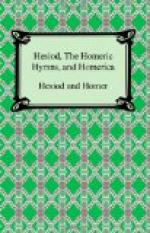Of all this mass of epic poetry only the scantiest fragments survive; but happily Photius has preserved to us an abridgment of the synopsis made of each poem of the “Trojan Cycle” by Proclus, i.e. Eutychius Proclus of Sicca.
The pre-Trojan poems of the Cycle may be noticed first. The “Titanomachy”, ascribed both to Eumelus of Corinth and to Arctinus of Miletus, began with a kind of Theogony which told of the union of Heaven and Earth and of their offspring the Cyclopes and the Hundred-handed Giants. How the poem proceeded we have no means of knowing, but we may suppose that in character it was not unlike the short account of the Titan War found in the Hesiodic “Theogony” (617 ff.).
What links bound the “Titanomachy” to the Theben Cycle is not clear. This latter group was formed of three poems, the “Story of Oedipus”, the “Thebais”, and the “Epigoni”. Of the “Oedipodea” practically nothing is known, though on the assurance of Athenaeus (vii. 277 E) that Sophocles followed the Epic Cycle closely in the plots of his plays, we may suppose that in outline the story corresponded closely to the history of Oedipus as it is found in the “Oedipus Tyrannus”. The “Thebais” seems to have begun with the origin of the fatal quarrel between Eteocles and Polyneices in the curse called down upon them by their father in his misery. The story was thence carried down to the end of the expedition under Polyneices, Adrastus and Amphiarus against Thebes. The “Epigoni” (ascribed to Antimachus of Teos) recounted the expedition of the `After-Born’ against Thebes, and the sack of the city.
The Trojan Cycle
Six epics with the “Iliad” and the “Odyssey”
made up the Trojan
Cycle — The “Cyprian Lays”,
the “Iliad”, the “Aethiopis”,
the
“Little Iliad”, the “Sack of Troy”,
the “Returns”, the
“Odyssey”, and the “Telegony”.
It has been assumed in the foregoing pages that the poems of the Trojan Cycle are later than the Homeric poems; but, as the opposite view has been held, the reasons for this assumption must now be given. 1) Tradition puts Homer and the Homeric poems proper back in the ages before chronological history began, and at the same time assigns the purely Cyclic poems to definite authors who are dated from the first Olympiad




